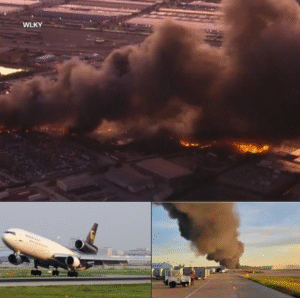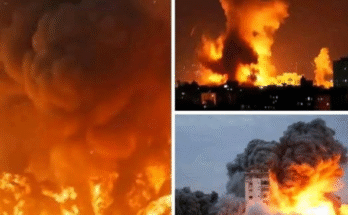Emergency Landing After Boeing Plane Engine Erupts in Flames
Shortly after take‑off from the Greek island of Corfu, a routine holiday charter turned momentarily into a nightmare: the right engine of a Boeing 757‑300, operating as Condor Airlines Flight DE 3665 bound for Düsseldorf, Germany, ignited in a dramatic burst of flames, prompting a swift diversion and emergency landing in Italy. Interesting Engineering+1
The Flight and the Incident
The aircraft lifted off from Corfu’s Ioannis Kapodistrias Airport at around 8:19 p.m. local time, carrying 273 passengers and eight crew. Interesting Engineering+2New York Post+2 The mood was one of routine expectation: a holiday flight to Düsseldorf, where passengers looked forward to returning home after a sun‑soaked trip.
But within minutes, field reports and recorded flight‑tracking data show that something was wrong. According to aviation‑news accounts, sparks and flames began streaming from the right engine as the aircraft climbed, prompting alarm among passengers and crew alike. Interesting Engineering+1 One passenger later said they had texted “goodbye” to loved ones, believing the worst was imminent. New York Post
What Happened in the Engine
Preliminary reports indicate the fire was caused by a “parameter indication outside the normal range,” linked to a disturbance in the engine’s airflow supply. Condor’s spokesperson offered a more specific note that a “chemical reaction in the combustion chamber” may have triggered the blaze. Yahoo Autos+1 While investigations are ongoing, one theory gaining traction is a suspected bird strike during climb‑out, which may have disrupted turbine airflow and precipitated the ignition. Interesting Engineering
The fact that the engine was visibly on fire at altitude—reportedly around 36,000 feet—added urgency to the situation. One social‑media clip showed vivid flames trailing from the right wing as the aircraft descended. New York Post+1 The dramatic image of fire against twilight sky stirred fear onboard and on the ground.
Crew Response and Landing
The pilots, trained for emergency procedures, declared an emergency and diverted to the nearest suitable airport—which in this case was Brindisi Airport in southern Italy. Interesting Engineering+1 Upon approach, the fire‑suppression teams were already standing by. The aircraft, though disabled on one engine, was equipped to fly on the remaining engine and other built‑in redundancies that modern airliners include for precisely these scenarios.
The landing was executed safely; no injuries to passengers or crew were reported. Aviation safety systems and training protocols did their job. Once on the ground, the plane rolled to a stop. Fire crews inspected the engine and the aircraft was taken out of service for detailed inspection. Passengers were accommodated in the local area—though hotel capacity was insufficient, leading some to stay in the airport lounge overnight—and were re‑routed to Düsseldorf the next day. Yahoo Autos
Passenger Experience and Response
For the people on board, what had begun as a typical holiday return flight turned into a moment of acute vulnerability. One passenger told Bild newspaper: “Suddenly, the power went out for a few seconds and we realised we were no longer climbing.” The Sun Others described loud booms, flames visible outside windows, and the unsettling sense of watching one’s own aircraft become a fireball in the sky. Social‑media posts from onlookers in Italy captured the sight of a burning plane descending, adding to the visceral impact. Interesting Engineering
Despite the terror, passengers applauded the crew’s calm professionalism afterward. Airlines later issued statements thanking those onboard for their composure and reiterating that safety remained the highest priority.
Implications and Aircraft Context
The incident raises broader questions about airline operations, air‑frame age, engine reliability, bird‑strike mitigation, and maintenance protocols. The Boeing 757 series—though a trusted workhorse—entered service decades ago and, in many fleets, operates under newer oversight regimes. Interesting Engineering Engine fires of this nature are rare for twin‑engine modern jets, but when they occur, they test the full chain of pilot training, maintenance integrity, and emergency planning.
Regulators like the Federal Aviation Administration (FAA) and international counterparts will closely review the event. Early action items will likely include engine examination, operations data‑recorder review, ambient air‑ingestion records (bird strike risk), maintenance logs for that engine, and review of decision‑making criteria for diversion and landing. Manufacturers and airlines may also revisit preventative checklists, especially where bird‑strike hazard zones intersect with take‑off/climb phases. Reuters+1
Why This Matters
From a safety‑engineering perspective, incidents like this highlight that air travel—while statistically extremely safe—still operates with inherent risk that must be constantly managed. The fact that so many redundant systems exist, and that pilots train for engine‑fire emergencies and one‑engine operations, is exactly what matters in cases like this. Passengers walking away unharmed is not luck alone, but the result of complex systems that anticipate failure and plan for worst‑case scenarios.
For passengers, such an event shakes confidence. Witnessing flames from an engine mid‑air is a visceral reminder of the power of machines and the importance of skilled human operators. Airlines, in response, must not just maintain hardware—but also communicate both transparently and reassuringly when events unfold. Clear communication from the cockpit and cabin crew can make a difference between panic and orderly cooperation.
What Comes Next
The investigation into the incident will proceed. Key questions include: What exactly triggered the fire? Was the bird‑strike theory confirmed? Were all engine‑monitoring parameters within limits before the event? Had maintenance logs shown early indicators? And did the airline’s operational decision‑making follow industry best practice? The answers will likely take months and may result in bulletins, service‑kit changes, and possibly fleet‑wide inspections.
Meanwhile, passengers were re‑booked and operations resumed. Airlines typically also conduct internal reviews of crew response, cabin announcements, emergency procedures, and passenger support. Regulatory risk aside, the reputational impact—both for Condor Airlines and for the Boeing 757 platform—must be managed carefully.
Conclusion
The emergency landing of a Boeing 757 after an engine burst into flames is a dramatic reminder of how quickly routine can turn into crisis at 30,000 feet. Thanks to trained professionals, redundant systems, and emergency protocols, a potentially catastrophic event ended with everyone safe. The sight of fire streaming from a jet engine remains chilling, but the outcome proves once more that modern air travel has layers of protection built into it.
In the aftermath, the technical facts will matter: maintenance history, engine condition, bird‑strike risk, system parameters, and decision‑making. Equally important will be the human factors: calm cockpit decisions, professional cabin crew, and informed passengers. For the travelers aboard Flight DE 3665, what happened will be remembered; for the industry at large, it provides a case study in vigilance, preparedness, and the importance of never assuming that everything will always go according to plan.


